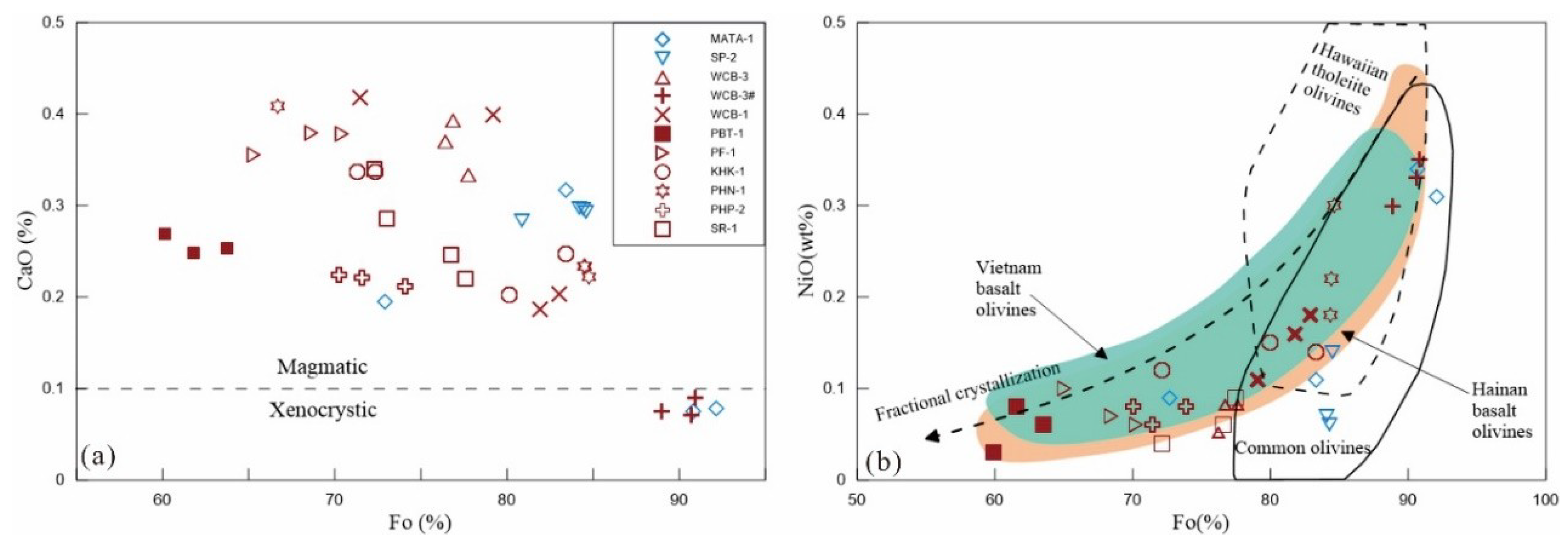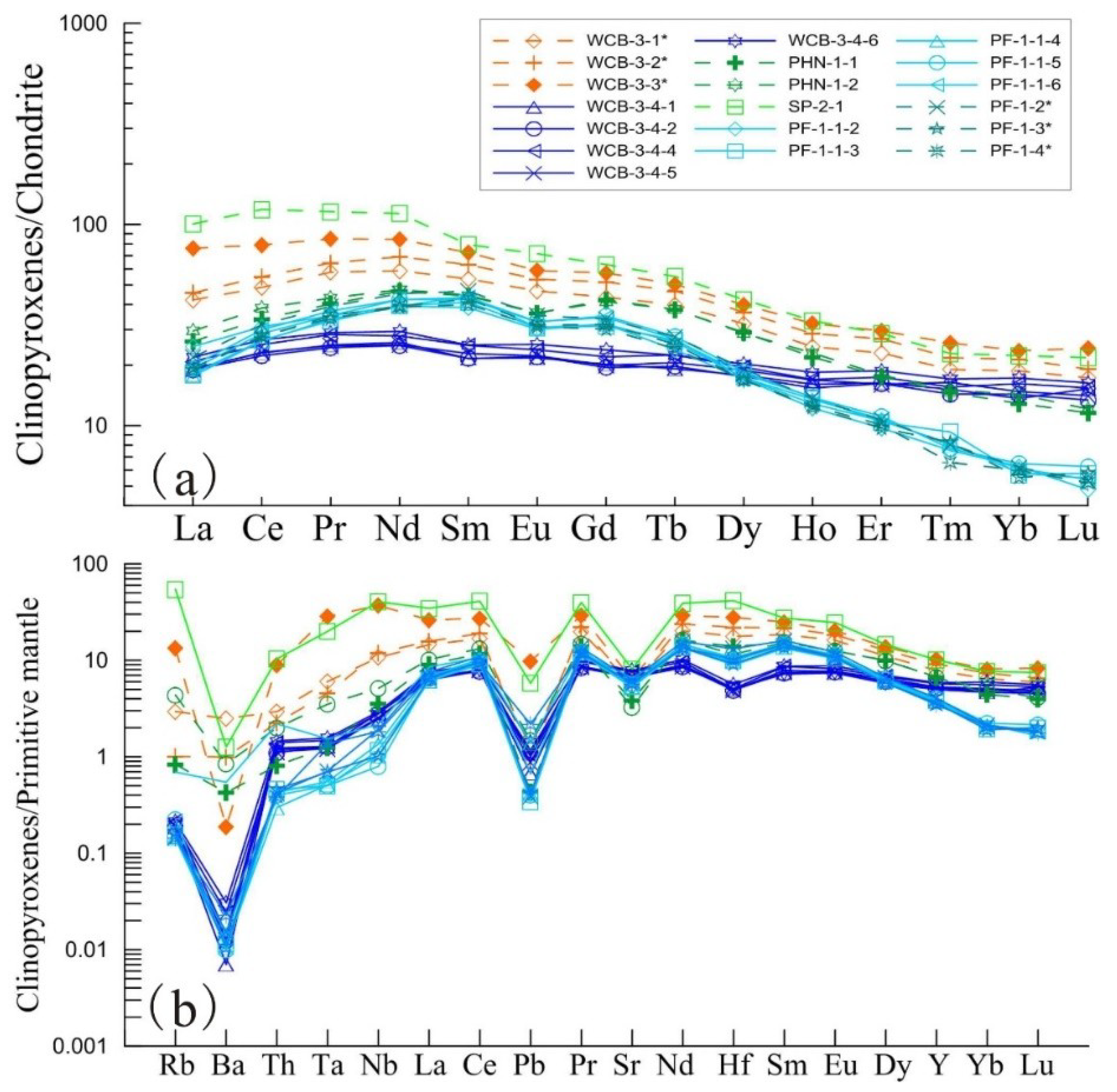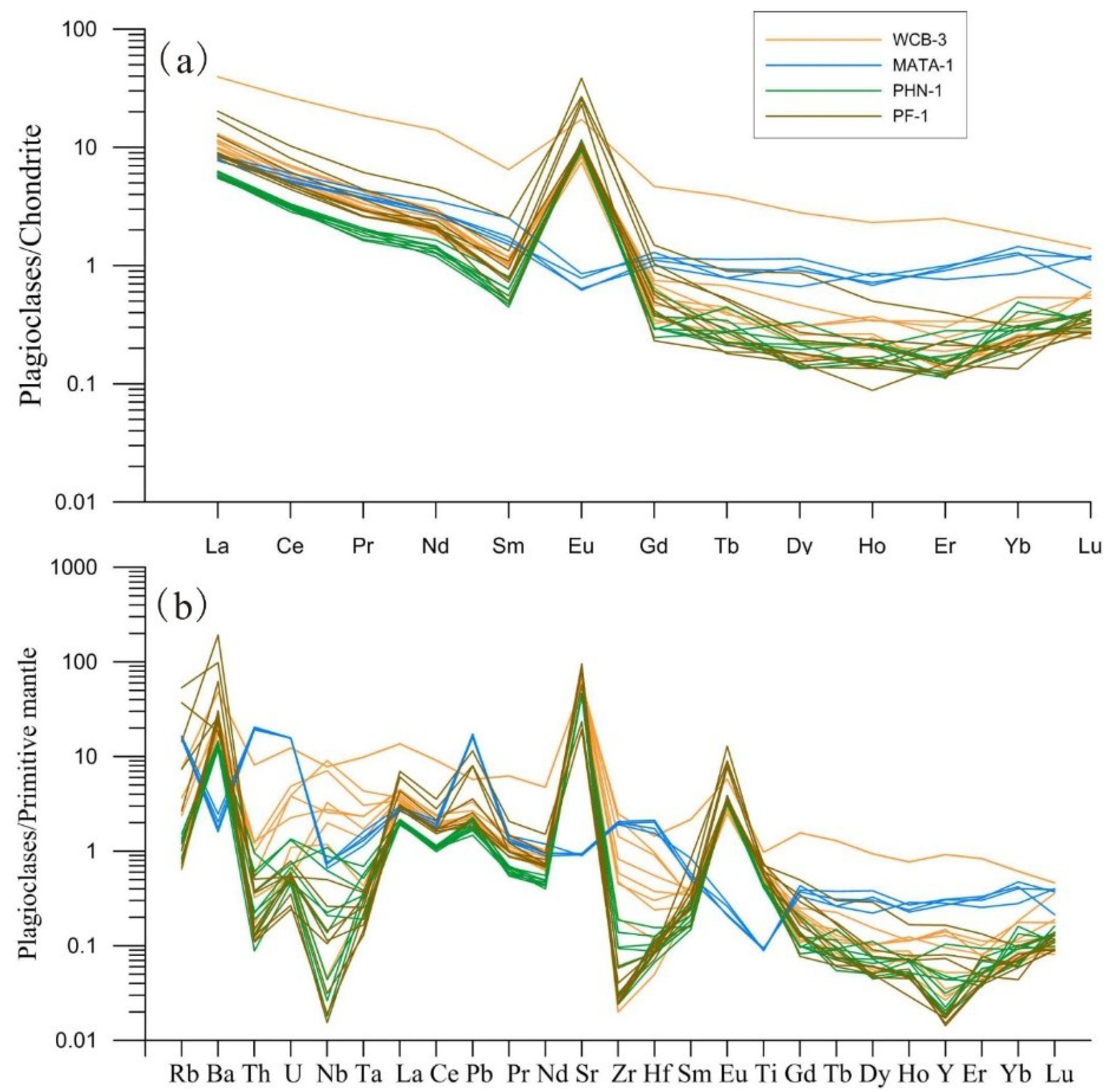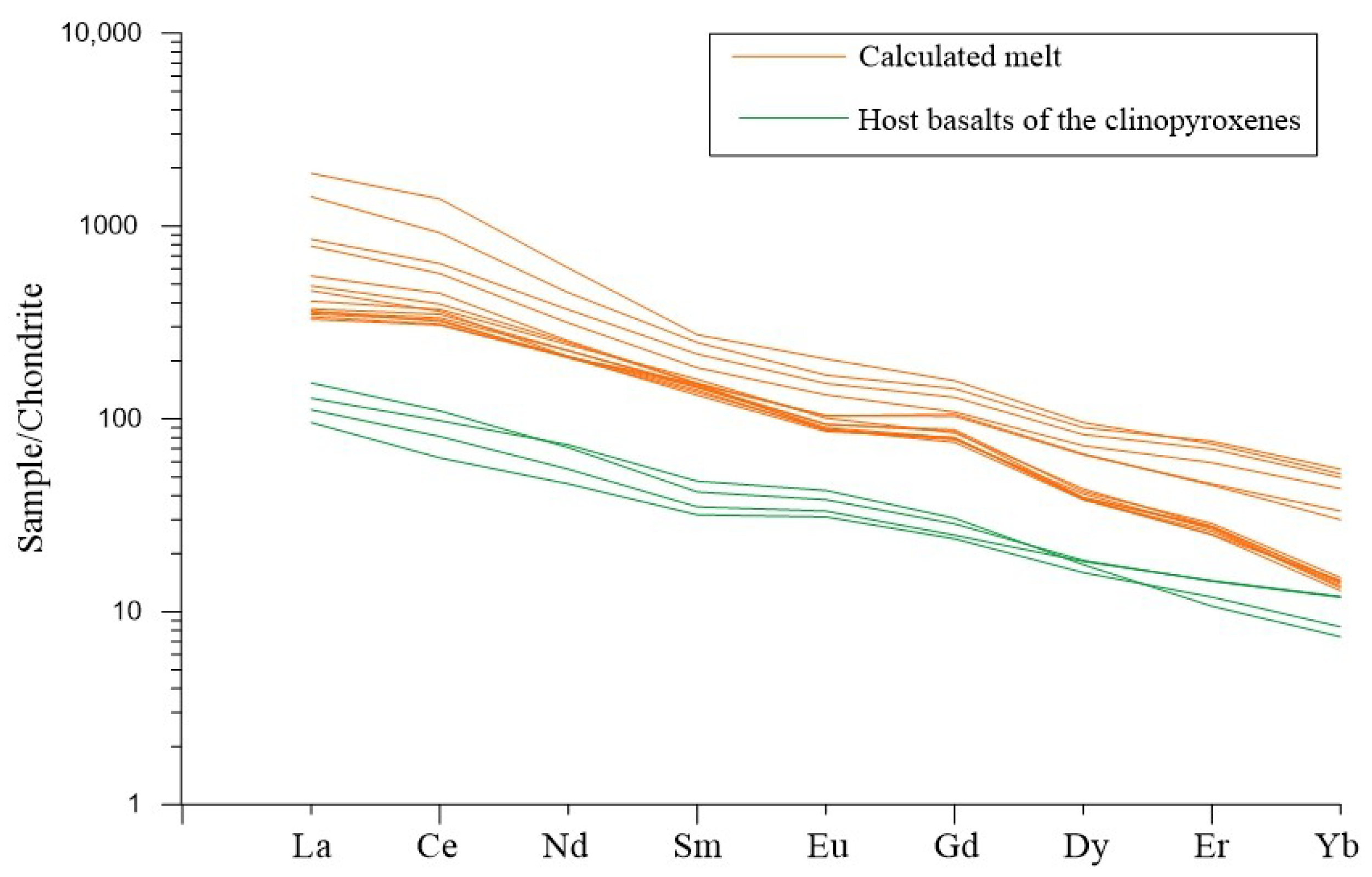In Situ LA-ICP-MS Analysis of Minerals Hosted by Late Cenozoic Basaltic Rocks from Thailand
Abstract
1. Introduction
2. Geological Setting and Sample Description
3. Methods and Results
3.1. Methods
3.2. Results
3.2.1. Olivine
3.2.2. Clinopyroxene
Major Element Composition
Trace Element Composition
3.2.3. Plagioclase
Major Element Composition
Trace Element Composition
4. Discussion
4.1. Nature of the Source Lithology
4.2. Primary Melt Compositions and the Mantle Potential Temperature
4.3. Physical Conditions of Crystallization
4.3.1. Crystallization Pressure and Temperature of Clinopyroxenes
4.3.2. Crystallization Pressure and Temperature of Plagioclase
4.4. Tectonic Implications
5. Conclusions
- (1)
- The order of mineral crystallization of the late Cenozoic basalts of Thailand was olivine, clinopyroxene, plagioclase, which is consistent with that of typical OIB. The source lithology of the Thailand basaltic rocks could be garnet pyroxenite.
- (2)
- The clinopyroxene discrimination diagrams exhibited that the parental-magma formed in an intraplate tectonic setting environment.
- (3)
- The crystallization pressure and temperature of clinopyroxenes in late Cenozoic basaltic rocks in Thailand ranged from 0.4–0.9 GPa and 1145–1214 °C, similar to those of the SCS basin and northern Hainan Island. The crystallization pressure and temperatures of plagioclase ranged from 0.3–0.9 Gpa and 1067 °C to 1133 °C, which is similar to those for the SCS. The above characteristics showed that parental magmas of late Cenozoic basaltic rocks from Thailand had experienced multiphase crystallization and fractionation during its ascent to the surface. Moreover, the plagioclase had a high An content, suggesting that it was produced during the rapid upwelling of magma.
- (4)
- The effective melting pressure and melting temperature based on the primary melts were 22.3–27.4 kbar and 1425–1442 °C, respectively, which was similar to the northern Hainan Island and the Southern Vietnam. The mantle potential temperature beneath Thailand is in the range 1448–1467 °C, slightly lower than north of Hainan Island and Southern Vietnam.
- (5)
- This study provides some additional important evidence (e.g., magmatic processes, mantle potential temperatures) for the Hainan mantle plume affecting Thailand and other areas in the Indochina block (e.g., Vietnam).
Supplementary Materials
Author Contributions
Funding
Acknowledgments
Conflicts of Interest
References
- Zou, H.P.; Li, P.L.; Rao, C.T. Geochemistry of Cenozoic volcanic rocks in Zhujiangkou basin and its geodynamic significance. Geochimica 1995, 24, 33–45. [Google Scholar]
- Chung, S.-L.; Cheng, H.; Jahn, B.-M.; O’Reilly, S.Y.; Zhu, B. Major and trace element, and Sr-Nd isotope constraints on the origin of Paleogene volcanism in South China prior to the South China Sea opening. Lithos 1997, 40, 203–220. [Google Scholar] [CrossRef]
- Li, P.L.; Liang, H.X.; Dai, Y.D.; Liu, H.M. Origin and tectonic setting of the Yanshanian igneous rocks in the Pearl River Mouth basin. Guangdong Geol. 1999, 14, 1–8. [Google Scholar]
- Zhou, H.; Xiao, L.; Dong, Y.; Wang, C.; Wang, F.; Ni, P. Geochemical and geochronological study of the Sanshui basin bimodal volcanic rock suite, China: Implications for basin dynamics in southeastern China. J. Asian Earth Sci. 2009, 34, 178–189. [Google Scholar] [CrossRef]
- Li, S.T.; Lin, C.S.; Zhang, Q.M. Dynamic process of episodic rifting in continental marginal basin and tectonic events since 10 Ma in South China Sea. Chin. Sci. Bull. 1998, 43, 797–810. [Google Scholar]
- Yan, Q.; Shi, X.; Castillo, P.R. The late Mesozoic–Cenozoic tectonic evolution of the South China Sea: A petrologic perspective. J. Asian Earth Sci. 2014, 85, 178–201. [Google Scholar] [CrossRef]
- Kudrass, H.; Wiedicke, M.; Cepek, P.; Kreuzer, H.; Muller, P. Mesozoic and Cainozoic rocks dredged from the South China Sea (Reed Bank area) and Sulu Sea and their significance for plate-tectonic reconstructions. Mar. Pet. Geol. 1986, 3, 19–30. [Google Scholar] [CrossRef]
- Tu, K.; Flower, M.; Carlson, R.W.; Xie, G.H.; Chen, C.Y.; Zhang, M. Magmatism in the South China basin. Chem. Geol. 1992, 97, 47–63. [Google Scholar] [CrossRef]
- Yan, Q.S.; Shi, X.F.; Wang, K.S.; Bu, W.R. Mineral chemistry and its genetic significance of olivine in Cenozoic basalts from the South China Sea. Acta Pet. Sin. 2007, 23, 2981–2989. [Google Scholar]
- Yan, Q.S.; Shi, X.F.; Liu, J.; Chang, L.H.; Yin, J. Chemical composition of plagioclase in Cenozoic alkali basalt from the South China Sea. Acta Miner. Sin. 2008, 28, 135–142. [Google Scholar]
- Yan, Q.S.; Shi, X.F.; Yang, Y.; Wang, K.S. Potassium-argon/argon-40-argon-39 geochronology of Cenozoic alkali basalts from the South China Sea. Acta Oceanol. Sin. 2008, 27, 115–123. [Google Scholar]
- Yan, Q.S.; Shi, X.F.; Wang, K.S.; Bu, W.R.; Xiao, L. Major element, trace element, and Sr, Nd and Pb isotope studies of Cenozoic basalts from the South China Sea. Sci. China Ser. D-Earth Sci. 2008, 51, 550–566. [Google Scholar] [CrossRef]
- Yan, Q.; Castillo, P.; Shi, X.; Wang, L.; Liao, L.; Ren, J. Geochemistry and petrogenesis of volcanic rocks from Daimao Seamount (South China Sea) and their tectonic implications. Lithos 2015, 218, 117–126. [Google Scholar] [CrossRef]
- Zhang, Y.; Yu, K.; Qian, H. LA-ICP-MS Analysis of Clinopyroxenes in Basaltic Pyroclastic Rocks from the Xisha Islands, Northwestern South China Sea. Minerals 2018, 8, 575. [Google Scholar] [CrossRef]
- Zhou, B.; Wang, H.F.; Mao, C.; Zhu, N.; Huang, R.; Peng, J. Geochronology of and Nd-Sr-Pb isotopic evidence for mantle source in the ancient subduction zone beneath Sanshui Basin, Guangdong Province, China. Acta Geochem. 1989, 8, 65–71. [Google Scholar]
- Jia, D.C.; Qiu, X.L.; Hu, R.Z.; Lu, Y. Geochemical nature of mantle reservoirs and tectonic setting of basalts in Beibu Gulf and its adjacent region. Trop. Oceanol. 2003, 22, 30–39. [Google Scholar]
- Li, C.N.; Wang, F.Z.; Zhong, C.S. Geochemistry of quaternary basaltic volcanic rocks of weizhou island in Beihai city of Guangxi and a discussion on characteristics of their source. Acta Pet. Miner. 2005, 24, 28–34. [Google Scholar]
- Wang, X.C.; Li, Z.X.; Li, X.H.; Li, J.; Liu, Y.; Long, W.G.; Zhou, J.B.; Wang, F. Temperature, pressure, and composition of the mantle source region of late Cenozoic basalts in Hainan Island, SE Asia: A consequence of a young thermal mantle plume close to subduction zones? J. Pet. 2012, 53, 177–233. [Google Scholar] [CrossRef]
- Zou, H.; Fan, Q. U–Th isotopes in Hainan basalts: Implications for sub-asthenospheric origin of EM2 mantle endmember and the dynamics of melting beneath Hainan Island. Lithos 2010, 116, 145–152. [Google Scholar] [CrossRef]
- Barr, S.M.; Macdonald, A.S. Geochemistry and geochronology of late Cenozoic basalts of Southeast Asia: Summary. Geol. Soc. Am. Bull. 1981, 92, 1069–1142. [Google Scholar] [CrossRef]
- Barr, S.; Dostal, J. Petrochemistry and origin of megacrysts in Upper Cenozoic basalts, Thailand. J. Asian Earth Sci. 1986, 1, 107–116. [Google Scholar] [CrossRef]
- Hoang, N.; Flower, M.F.; Carlson, R.W. Major, trace element, and isotopic compositions of Vietnamese basalts: Interaction of hydrous EM1-rich asthenosphere with thinned Eurasian lithosphere. Geochim. Cosmochim. Acta 1996, 60, 4329–4351. [Google Scholar] [CrossRef]
- Hoang, N.; Flower, M. Petrogenesis of Cenozoic Basalts from Vietnam: Implication for Origins of a ‘Diffuse Igneous Province’. J. Pet. 1998, 39, 369–395. [Google Scholar] [CrossRef]
- Barr, S.; Cooper, M. Late Cenozoic basalt and gabbro in the subsurface in the Phetchabun Basin, Thailand: Implications for the Southeast Asian Volcanic Province. J. Asian Earth Sci. 2013, 76, 169–184. [Google Scholar] [CrossRef]
- An, A.-R.; Choi, S.H.; Yu, Y.; Lee, D.-C. Petrogenesis of Late Cenozoic basaltic rocks from southern Vietnam. Lithos 2017, 272, 192–204. [Google Scholar] [CrossRef]
- Yan, Q.; Shi, X.; Metcalfe, I.; Liu, S.; Xu, T.; Kornkanitnan, N.; Sirichaiseth, T.; Yuan, L.; Zhang, Y.; Zhang, H. Hainan mantle plume produced late Cenozoic basaltic rocks in Thailand, Southeast Asia. Sci. Rep. 2018, 8, 2640. [Google Scholar] [CrossRef]
- Zhou, P.; Mukasa, S.B. Nd Sr Pb isotopic, and major- and trace-element geochemistry of Cenozoic lavas from the Khorat Plateau, Thailand: Sources and petrogenesis. Chem. Geol. 1997, 137, 175–193. [Google Scholar] [CrossRef]
- Yan, Q.; Straub, S.; Shi, X. Hafnium isotopic constraints on late Miocene to Pliocene seamount basalts from the South China Sea and its tectonic implications. J. Asian Earth Sci. 2019, 171, 162–168. [Google Scholar] [CrossRef]
- Choi, S.H.; Mukasa, S.B.; Kwon, S.T.; Andronikov, A.V. Sr, Nd, Pb and Hf isotopic compositions of late Cenozoic alkali basalts in south Korea: Evidence for mixing between the two dominant asthenospheric mantle domains beneath east Asia. Chem. Geol. 2006, 232, 134–151. [Google Scholar] [CrossRef]
- Metcalfe, I. Palaeozoic–Mesozoic history of SE Asia. Geol. Soc. Lond. Spéc. Publ. 2011, 355, 7–35. [Google Scholar] [CrossRef]
- Metcalfe, I. Gondwana dispersion and Asian accretion: Tectonic and palaeogeographic evolution of eastern Tethys. J. Asian Earth Sci. 2013, 66, 1–33. [Google Scholar] [CrossRef]
- Yan, Q.; Metcalfe, I.; Shi, X. U-Pb isotope geochronology and geochemistry of granites from Hainan Island (northern South China Sea margin): Constraints on late Paleozoic-Mesozoic tectonic evolution. Gondwana Res. 2017, 49, 333–349. [Google Scholar] [CrossRef]
- McCabe, R.; Celaya, M.; Cole, J.; Han, H.-C.; Ohnstad, T.; Paijitprapapon, V.; Thitipawarn, V. Extension tectonics: The Neogene opening of the north–south trending basins of central Thailand. J. Geophys. Res. Solid Earth 1988, 93, 11899–11910. [Google Scholar] [CrossRef]
- Lu, Y.F. Geokit-A geochemical toolkit for Microsoft Excel. Geochimica 2004, 33, 459–464, (In Chinese with English Abstract). [Google Scholar]
- Thompson, R.N.; Gibson, S.A.; Thompson, R.N.R.N.; Gibson, S.S.A. Transient high temperatures in mantle plume heads inferred from magnesian olivines in Phanerozoic picrites. Nature 2000, 407, 502–506. [Google Scholar] [CrossRef]
- Xu, Y.; Huang, X.; Menzies, M.A.; Wang, R. Highly magnesian olivines and green-core clinopyroxenes in ultrapotassic lavas from western Yunnan, China: Evidence for a complex hybrid origin. Eur. J. Miner. 2003, 15, 965–975. [Google Scholar] [CrossRef]
- Sobolev, A.V.; Hofmann, A.W.; Sobolev, S.V.; Nikogosian, I.K. An olivine-free mantle source of Hawaiian shield basalts. Nature 2005, 434, 590–597. [Google Scholar] [CrossRef]
- Sato, H. Nickel content of basaltic magmas: Identification of primary magmas and a measure of the degree of olivine fractionation. Lithos 1977, 10, 113–120. [Google Scholar] [CrossRef]
- Larsen, L.M.; Pedersen, A.K. Processes in High-Mg, High-T Magmas: Evidence from Olivine, Chromite and Glass in Palaeogene Picrites from West Greenland. J. Pet. 2000, 41, 1071–1098. [Google Scholar] [CrossRef]
- Morimoto, N. Nomenclature of pyroxenes. Miner. Pet. 1988, 39, 55–76. [Google Scholar] [CrossRef]
- Stone, S.; Niu, Y. Origin of compositional trends in clinopyroxene of oceanic gabbros and gabbroic rocks: A case study using data from ODP Hole 735B. J. Volcanol. Geotherm. Res. 2009, 184, 313–322. [Google Scholar] [CrossRef]
- Hart, S.R.; Dunn, T. Experimental cpx/melt partitioning of 24 trace elements. Contrib. Miner. Pet. 1993, 113, 1–8. [Google Scholar] [CrossRef]
- Hoang, T.H.A.; Choi, S.H.; Yu, Y.; Pham, T.H.; Nguyen, K.H.; Ryu, J.-S. Geochemical constraints on the spatial distribution of recycled oceanic crust in the mantle source of late Cenozoic basalts, Vietnam. Lithos 2018, 296, 382–395. [Google Scholar] [CrossRef]
- Sun, S.-S.; Mc Donough, W. Chemical and isotopic systematics of oceanic basalts: Implications for mantle composition and processes. Geol. Soc. Lond. Spéc. Publ. 1989, 42, 313–345. [Google Scholar] [CrossRef]
- Wang, J.M.; Ding, G.C. The negative Eu Anomaly of Feldspar in Suzhou A-type Granite and its origin significance. Dizhi Shiyanshi 1995, 11, 108–111, (In Chinese with English Abstract). [Google Scholar]
- Liu, Y.; Gao, S.; Kelemen, P.B.; Xu, W. Recycled crust controls contrasting source compositions of Mesozoic and Cenozoic basalts in the North China Craton. Geochim. Cosmochim. Acta 2008, 72, 2349–2376. [Google Scholar] [CrossRef]
- Yang, Z.-F.; Zhou, J.-H. Can we identify source lithology of basalt? Sci. Rep. 2013, 3, 1856. [Google Scholar] [CrossRef]
- Herzberg, C.; Asimow, P.D. Petrology of some oceanic island basalts: PRIMELT2.XLS software for primary magma calculation. Geochem. Geophys. Geosyst. 2008, 9. [Google Scholar] [CrossRef]
- Klemme, S.; O’Neill, H.S. The near-solidus transition from garnet lherzolite to spinel lherzolite. Contrib. Miner. Pet. 2000, 138, 237–248. [Google Scholar] [CrossRef]
- Shaw, D.M. Trace element fractionation during anataxis. Geochim. Cosmochim. Acta 1977, 34, 237–243. [Google Scholar] [CrossRef]
- Tamura, Y.; Ishizuka, O.; Sato, T.; Nichols, A.R.L. Nishinoshima volcano in the Ogasawara Arc: New continent from the ocean? Isl. Arc 2018, 28, e12285. [Google Scholar] [CrossRef]
- Kelemen, P.B.; Shimizu, N.; Dunn, T. Relative depletion of niobium in some arc magmas and the continental crust: Partitioning of K, Nb, La and Ce during melt/rock reaction in the upper mantle. Earth Planet. Sci. Lett. 1993, 120, 111–134. [Google Scholar] [CrossRef]
- Albarède, F. How deep do common basaltic magmas form and differentiate? J. Geophys. Res. Solid Earth 1992, 97, 10997–11009. [Google Scholar] [CrossRef]
- Haase, K.M. The relationship between the age of the lithosphere and the composition of oceanic magmas: Constraints on partial melting, mantle sources and the thermal structure of the plates. Earth Planet. Sci. Lett. 1996, 144, 75–92. [Google Scholar] [CrossRef]
- Kelley, K.A.; Terry, P.; Grove, T.L.; Stolper, E.M.; Sally, N.; Erik, H. Mantle melting as a function of water content beneath back-arc basins. J. Geophys. Res. Solid Earth 2006, 111. [Google Scholar] [CrossRef]
- Putirka, K.D.; Perfit, M.; Ryerson, F.; Jackson, M.G. Ambient and excess mantle temperatures, olivine thermometry, and active vs. passive upwelling. Chem. Geol. 2007, 241, 177–206. [Google Scholar] [CrossRef]
- Herzberg, C.; Gazel, E. Petrological evidence for secular cooling in mantle plumes. Nature 2009, 458, 619–622. [Google Scholar] [CrossRef]
- Shellnutt, J.G.; Pham, T.T. Mantle Potential Temperature Estimates and Primary Melt Compositions of the Low-Ti Emeishan Flood Basalt. Front. Earth Sci. 2018, 6, 67. [Google Scholar] [CrossRef]
- Putirka, K.D. Thermometers and Barometers for Volcanic Systems. Rev. Miner. Geochem. 2008, 69, 61–120. [Google Scholar] [CrossRef]
- Herzberg, C.; Asimow, P.D.; Arndt, N.; Niu, Y.; Lesher, C.M.; Fitton, J.G.; Cheadle, M.J.; Saunders, A.D. Temperatures in ambient mantle and plumes: Constraints from basalts, picrites, and komatiites. Geochem. Geophys. Geosyst. 2007, 8. [Google Scholar] [CrossRef]
- Putirka, K.D. Mantle potential temperatures at Hawaii, Iceland, and the mid-ocean ridge system, as inferred from olivine phenocrysts: Evidence for thermally driven mantle plumes. Geochem. Geophys. Geosyst. 2005, 6. [Google Scholar] [CrossRef]
- Putirka, K.; Johnson, M.; Kinzler, R.; Longhi, J.; Walker, D. Thermobarometry of mafic igneous rocks based on clinopyroxene-liquid equilibria, 0-30 kbar. Contrib. Miner. Pet. 1996, 123, 92–108. [Google Scholar] [CrossRef]
- Ashchepkov, I.; André, L.; Downes, H.; Belyatsky, B.; Ashchepkov, I. Pyroxenites and megacrysts from Vitim picrite-basalts (Russia): Polybaric fractionation of rising melts in the mantle? J. Asian Earth Sci. 2011, 42, 14–37. [Google Scholar] [CrossRef]
- Ashchepkov, I.; Ntaflos, T.; Logvinova, A.; Spetsius, Z.; Downes, H.; Vladykin, N.; Ashchepkov, I. Monomineral universal clinopyroxene and garnet barometers for peridotitic, eclogitic and basaltic systems. Geosci. Front. 2017, 8, 775–795. [Google Scholar] [CrossRef]
- Kudo, A.M.; Weill, D.F. An igneous plagioclase thermometer. Miner. Pet. 1970, 25, 52–65. [Google Scholar] [CrossRef]
- Chen, X.M.; Tan, Q.Q.; Zhao, G.T. Plagioclases from the basalt of Okinawa trough and its petrogenesis significance. Acta Miner. Sin. 2002, 18, 482–488. [Google Scholar]
- Aparicio, A. Relationship between clinopyroxene composition and the formation environment of volcanic host rocks. IUP J. Earth Sci. 2010, 4, 1–11. [Google Scholar]
- Gilman, T.; Feineman, M.; Fisher, D. The Chulitna terrane of south-central Alaska: A rifted volcanic arc caught between the Wrangellia composite terrane and the Mesozoic margin of North America. Geol. Soc. Am. Bull. 2009, 121, 979–991. [Google Scholar] [CrossRef]
- Tang, D.; Qin, K.; Chen, B.; Mao, Y.; Guo, H.; Evans, N.J. Mineral chemistry and genesis of the Permian Cihai and Cinan magnetite deposits, Beishan, NW China. Ore Geol. Rev. 2017, 86, 79–99. [Google Scholar] [CrossRef]
- Nisbet, E.G.; Pearce, J.A. Clinopyroxene composition in mafic lavas from different tectonic settings. Contrib. Miner. Pet. 1977, 63, 149–160. [Google Scholar] [CrossRef]
- Lai, S.C.; Qin, J.F.; Li, Y.F. Trace element geochemistry and classification of the Clinopyroxene in Cenozoic trachybasalt from north Qiangtang area, Tibetan Plateau. J. Northwest Univ. 2005, 25, 611–616. [Google Scholar]
- Lebedev, S.; Nolet, G. Upper mantle beneath southeast Asia from S velocity tomography. J. Geophys. Res. Solid Earth 2003, 108. [Google Scholar] [CrossRef]
- Lei, J.; Zhao, D.; Steinberger, B.; Wu, B.; Shen, F.; Li, Z. New seismic constraints on the upper mantle structure of the Hainan plume. Phys. Earth Planet. Inter. 2009, 173, 33–50. [Google Scholar] [CrossRef]
- Huang, J. P- and S-wave tomography of the Hainan and surrounding regions: Insight into the Hainan plume. Tectonophysics 2014, 633, 176–192. [Google Scholar] [CrossRef]
- Zhao, D. Seismic images under 60 hotspots: Search for mantle plumes. Gondwana Res. 2007, 12, 335–355. [Google Scholar] [CrossRef]











| Starting Sample | WCB-1 | WCB-2 | WCB-3 | MATA-2 | Southern Vietnam | Northern Hainan |
|---|---|---|---|---|---|---|
| Rock type | Trachybasalt | Trachybasalt | Trachybasalt | Basanite | Basanite | |
| Olivine add (%) | 15 | 15 | 17 | 16 | 13–15 | 18–25 |
| SiO2 | 47.3 | 47.1 | 47.3 | 45.9 | - | |
| TiO2 | 1.7 | 1.7 | 1.7 | 1.9 | ||
| Al2O3 | 13.2 | 13.8 | 13.3 | 12.9 | ||
| Cr2O3 | 0.0 | 0.0 | 0.0 | 0.0 | ||
| Fe2O3 | 0.8 | 0.9 | 0.8 | 1.0 | ||
| FeO | 8.8 | 8.7 | 8.6 | 9.5 | ||
| MnO | 0.2 | 0.2 | 0.2 | 0.2 | ||
| MgO | 15.3 | 15.2 | 15.9 | 15.1 | ||
| CaO | 7.5 | 7.3 | 7.4 | 7.7 | ||
| Na2O | 2.8 | 2.9 | 2.5 | 3.2 | ||
| K2O | 1.9 | 2.0 | 1.9 | 2.2 | ||
| NiO | 0.0 | 0.0 | 0.0 | 0.0 | ||
| P2O5 | 0.4 | 0.4 | 0.4 | 0.4 | ||
| H2O | 1.0 | 1.0 | 1.0 | 1.6 | ||
| F (%) | 13.0 | 12.4 | 15.5 | 7.1 | 4–7 | 14–19 |
| Pf1 | 24.8 | 25.9 | 25.0 | 30.9 | 33.6–36.6 | 17.2–33.7 |
| Pf2 | 19.8 | 20.5 | 20.7 | 23.9 | 27.5–30.4 | 15.6–30.2 |
| Pf3 | 22.3 | 23.2 | 22.9 | 27.4 | 29.7–32.8 | 17.8–31.6 |
| SD | 2.5 | 2.7 | 2.1 | 3.5 | 3–4 | 1.5–3.6 |
| T1 | 1457 | 1457 | 1471 | 1464 | - | - |
| T2 | 1396 | 1394 | 1412 | 1391 | 1444–1459 | 1429–1514 |
| T3 | 1426 | 1425 | 1442 | 1427 | 1463–1480 | 1420–1529 |
| SD | 30 | 31 | 30 | 36 | 16–22 | 3–34 |
| TP1 | 1466 | 1464 | 1481 | 1461 | - | - |
| TP2 | 1442 | 1440 | 1458 | 1437 | 1469–1482 | 1454–1536 |
| TP3 | 1447 | 1443 | 1462 | 1445 | 1458–1496 | 1413–1611 |
| TP4 | 1452 | 1449 | 1467 | 1448 | 1468–1490 | 1468–1561 |
| SD | 10 | 11 | 10 | 10 | 1–9 | 25–55 |
| Regions | Clinopyroxene | Plagioclase | References | ||
|---|---|---|---|---|---|
| T (°C) | P (Gpa) | T (°C) | P (Gpa) | ||
| Thailand | 1145–1214 | 0.4–0.9 | 1067–1133 | 0.3–0.9 | This study |
| Hainan Island | 1100–1250 | 0.7–1.5 | - | - | Wang et al. [18] |
| South China Sea basin | 1095–1261 | 0.4–1.5 | 927–1179 | - | Yan et al. [9,10] |
| Okinawa trough | - | - | 1012–1280 | - | Chen et al. [66] |
© 2019 by the authors. Licensee MDPI, Basel, Switzerland. This article is an open access article distributed under the terms and conditions of the Creative Commons Attribution (CC BY) license (http://creativecommons.org/licenses/by/4.0/).
Share and Cite
Yuan, L.; Yan, Q.; Shi, X.; Zhang, H.; Liu, X. In Situ LA-ICP-MS Analysis of Minerals Hosted by Late Cenozoic Basaltic Rocks from Thailand. Minerals 2019, 9, 446. https://doi.org/10.3390/min9070446
Yuan L, Yan Q, Shi X, Zhang H, Liu X. In Situ LA-ICP-MS Analysis of Minerals Hosted by Late Cenozoic Basaltic Rocks from Thailand. Minerals. 2019; 9(7):446. https://doi.org/10.3390/min9070446
Chicago/Turabian StyleYuan, Long, Quanshu Yan, Xuefa Shi, Haitao Zhang, and Xijun Liu. 2019. "In Situ LA-ICP-MS Analysis of Minerals Hosted by Late Cenozoic Basaltic Rocks from Thailand" Minerals 9, no. 7: 446. https://doi.org/10.3390/min9070446
APA StyleYuan, L., Yan, Q., Shi, X., Zhang, H., & Liu, X. (2019). In Situ LA-ICP-MS Analysis of Minerals Hosted by Late Cenozoic Basaltic Rocks from Thailand. Minerals, 9(7), 446. https://doi.org/10.3390/min9070446





